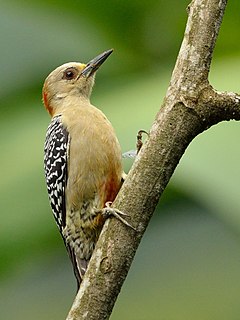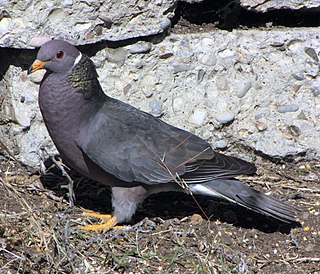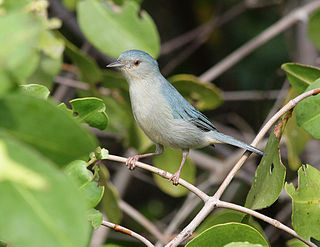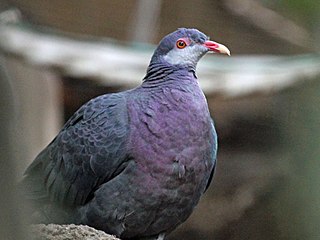
The bearded bellbird also known as the campanero or anvil-bird, is a passerine bird which occurs in northern South America. The male is about 28 cm (11 in) long with white plumage apart from a brown head and black wings. At his throat hang several black, unfeathered wattles. The female is a little smaller with olive-green head and upper parts, yellow underparts streaked with green and a yellow vent area. The male has a loud, repeated metallic hammering call, as well as various other vocalisations.

The white-tipped dove is a large New World tropical dove. Its scientific name commemorates the French naturalists Jules and Edouard Verreaux.

The red-crowned woodpecker is a resident breeding bird from southwestern Costa Rica, Panama, Colombia, Venezuela, the Guianas and Tobago.

The band-tailed pigeon is a medium-sized bird of the Americas. Its closest relatives are the Chilean pigeon and the ring-tailed pigeon, which form a clade of Patagioenas with a terminal tail band and iridescent plumage on their necks. There are at least 8 sub-species, and some authorities split this species into the northern band-tailed pigeon and the southern band-tailed pigeon.

The bicolored conebill is a small passerine bird. This member of the tanager family is a resident breeder in South America from Colombia, Venezuela and Trinidad south and east to the Guianas, northeast Peru and Brazil.

The scaled pigeon is a large New World tropical dove. It is a resident breeder from southern Mexico south to western Ecuador, southern Brazil, northern Argentina, and Trinidad.

The eared dove is a New World dove. It is a resident breeder throughout South America from Colombia to southern Argentina and Chile, and on the offshore islands from the Grenadines southwards. It may be a relatively recent colonist of Tobago and Trinidad. It appears to be partially migratory, its movements driven by food supplies.

The collared plover is a small shorebird in the plover family, Charadriidae. It lives along coasts and riverbanks of the tropical to temperate Americas, from central Mexico south to Chile and Argentina.

The red-billed pigeon is a relatively large, robust species of pigeon. It's breeding range extends from southern Texas, United States, to Costa Rica. It's primarily found throughout coastal and lowland areas of Mexico and Central America. It belongs to a clade of Patagioenas which generally lack iridescent display plumage, except some vestiges in the pale-vented pigeon.

The short-billed pigeon is a largish pigeon which breeds from southern Mexico south to northwestern Colombia. It is a member of a clade of Patagioenas that contains the smaller and rather plain species with characteristic calls that constitute the subgenus Oenoenas.

The ruddy pigeon is a largish pigeon which breeds from Costa Rica south to western Ecuador, Bolivia, and central Brazil. It belongs to a clade of small and rather plain species of Patagioenas with characteristic calls that constitute the subgenus Oenoenas. Like the other New World pigeons, it was formerly united with their Old World relatives in Columba, but today the New World genus Patagioenas is recognized as distinct again.

The ruddy-capped nightingale-thrush is a small thrush which is a resident breeder in mountain forests from central Mexico to western Panama. A predominantly brown-plumaged bird, it has a rich song.

The scarlet-rumped tanager is a medium-sized passerine bird. This tanager is a resident breeder in the Caribbean lowlands from southern Mexico to western Panama. This species was formerly known as the scarlet-rumped tanager, but was renamed when the distinctive form found on the Pacific coast of Costa Rica and Panama was reclassified as a separate species, the Cherrie's tanager, Ramphocelus costaricensis. While most authorities have accepted this split, there are notable exceptions. It was renamed back to the scarlet-rumped tanager in 2018 when Cherrie's Tanager was lumped back into the species.

Patagioenas is a genus of New World pigeons whose distinctness from the genus Columba was long disputed but ultimately confirmed. It is basal to the Columba-Streptopelia radiation. Their ancestors diverged from that lineage probably over 8 million years ago. While the biogeographic pattern of this group suggests that the ancestors of the typical pigeons and turtle-doves settled the Old World from the Americas, Patagioenas may just as well be the offspring of Old World pigeons which only radiated into different genera later, given that the cuckoo-doves (Macropygia) of Southeast Asia also seem to be closely related.
The Tasman starling was described in 1836 by John Gould as a species which occurred on both Norfolk Island and Lord Howe Island. In 1928 Australian ornithologist Gregory Mathews recognized that the plumage of the race from Lord Howe Island was much browner and more greyish than the plumage of the Norfolk Island race and split the species into two forms, the Norfolk starling, and the Lord Howe starling. Both subspecies are now extinct, thus so the species.

The metallic pigeon, also known as white-throated pigeon is a medium-sized, up to 37 cm long, bird in the family Columbidae.

The African olive pigeon or Rameron pigeon is a pigeon which is a resident breeding bird in much of eastern and southern Africa from Ethiopia to the Cape. Populations also are found in western Angola, southwestern Saudi Arabia and northern Yemen. It is locally common, although sizeable gaps in its distribution occur due to its habitat requirements.

The western bronze-naped pigeon is a species of bird in the family Columbidae, part of the subgenus Turturoena. A medium sized bird, it has a pale, broad terminal tail band which is noticeable on landing. It is found in most countries of Africa. The IUCN Red List classifies it as a species of least concern.

The spot-winged pigeon is a species of bird in the family Columbidae. It is found in Argentina, Bolivia, Brazil, Chile, Paraguay, Peru, and Uruguay.

The Seram mountain pigeon is a species of bird in the pigeon family Columbidae that is endemic to the island of Seram in Indonesia, where it inhabits hill forest. It was long considered to be a subspecies of the Buru mountain pigeon, but was split on the basis of differences in appearance. It is a medium-sized pigeon with a buff-pink face and breast, wine-pink underparts, a grey nape, crown, back of neck, and thighs, and dark chestnut belly and underside of the tail.






















